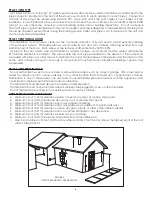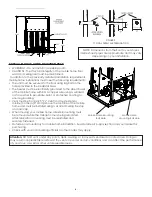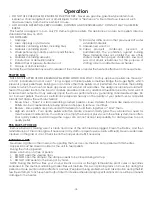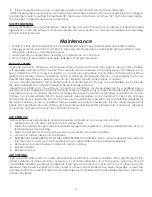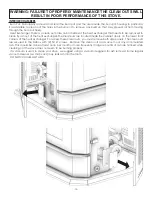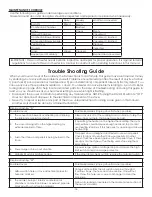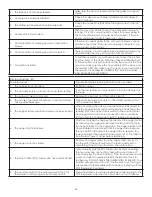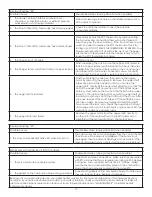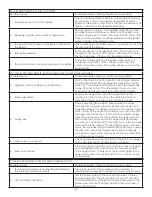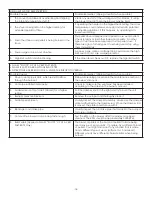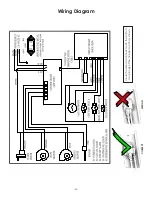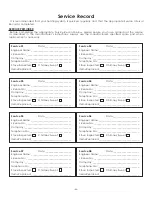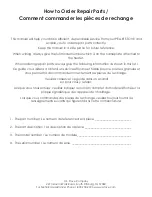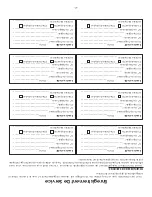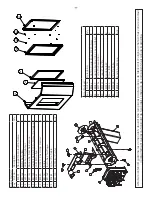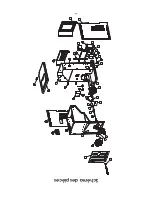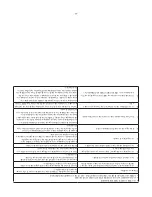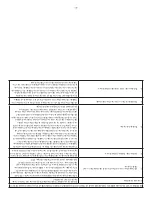
-18-
STOVE FEEDS PELLETS, BUT WILL NOT IGNITE
Possible Causes
Possible Remedies: (Unplug stove first when possible)
1.
Air damper open too far for ignition.
Push the air damper left for startup. In some situations it may
be necessary to have the damper completely closed for
ignition to take place. After there is a flame, the damper can
then be adjusted for the desired feed setting.
2. Blockage in igniter tube or inlet for igniter tube.
Find the igniter housing on the backside of the firewall. The
air intake hole is a small hole located on bottom side of the
housing. Make sure it is clear. Also, look from the front of the
stove to make sure there is not any debris around the igniter
element inside of the igniter housing.
3. The burnpot is not pushed completely to the rear of
the firebox.
Make sure that the air intake collar on the burnpot is touching
the rear wall of the firebox.
4.
Bad igniter element.
Put power directly to the igniter element. Watch the tip of
the igniter from the front of the stove. After about 2 minutes
the tip should glow. If it does not, the element is bad.
5.
The control board is not sending power to the igniter.
Check the voltage going to the igniter during startup. It
should be a full current. If the voltage is lower than full
current, check the wiring. If the wiring checks out good, the
board is bad.
STOVE WILL NOT FEED PELLETS, BUT FUEL FEED LIGHT COMES ON AS DESIGNED
Possible Causes
Possible Remedies: (Unplug stove first when possible)
1. High limit switch has tripped or is defective.
Wait for the stove to cool for about 30 - 45 minutes. Locate
the High Limit thermodisc and press the reset button on the
back of it. If the heater will not restart, check the thermodisc
to see if it’s bad. To test if the thermodisc is bad, you can
bypass it as described previously for the POF thermodisc.
2. Bad Auger Motor.
Remove the auger motor from the auger shaft and try to
run the unit. If the motor will turn, the shaft is jammed on
something. If the motor will not turn, the motor is bad.
3. Auger Jam.
Start by emptying the hopper. Then remove the auger
motor by removing the auger pin. Remove the auger shaft
inspection plate in the hopper so that you can see the auger
shaft. Gently lift the auger shaft straight up so that the end of
the auger shaft comes up out of the bottom auger bushing.
Next, remove the two nuts that hold the top auger biscuit in.
Then rotate the bottom end of the auger shaft up towards
you until you can lift the shaft out of the stove. After you have
removed the shaft, inspect it for bent flights, burrs, or broken
welds. Remove any foreign material that might have caused
the jam. Also, check the auger tube for signs of damage
such as burrs, rough spots, or grooves cut into the metal that
could have caused a jam.
4. Loose wire or connector.
Check all wires and connectors that connector to the auger
motor, high limit switch, and the Molex connector.
5. Bad control board.
If the fuse is good, the wires and connectors check out good,
and the high limit switch did not trip, test for power going
to the auger motor. If there is not a full current going to the
auger motor when the fuel feed light is on, you have a bad
control board.
CONVECTION BLOWER SHUTS OFF AND COMES BACK ON
Possible Causes
Possible Remedies: (Unplug stove first when possible)
1. The convection blower is overheating and tripping
the internal temperature shutoff.
Clean any dust off of the windings and fan blades. If
cleaning the blower does not help, the blower may be bad.
2. Circuit board malfunction.
Test the current going to the convection blower. If there is
power being sent to the blower when it is shut off, then the
control board is fine. If there is NOT power being sent to the
blower when it shuts off during operation, then you have a
bad control board.



